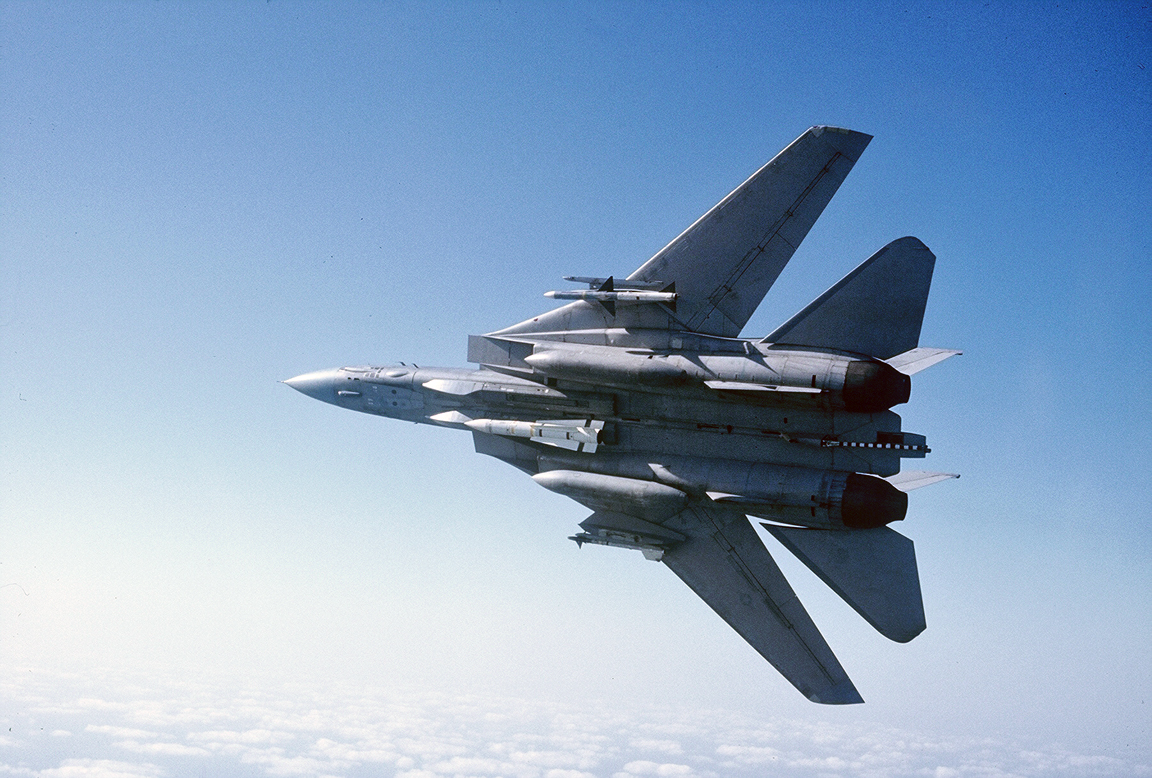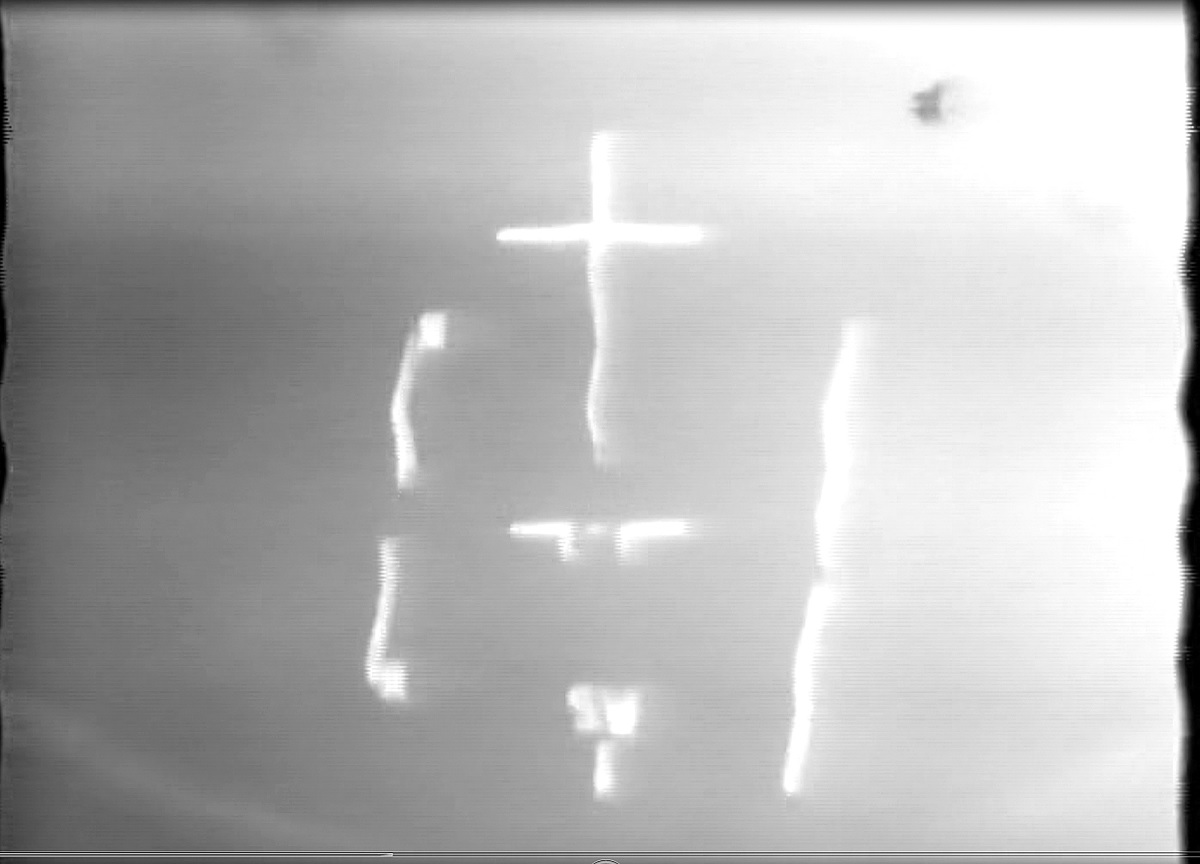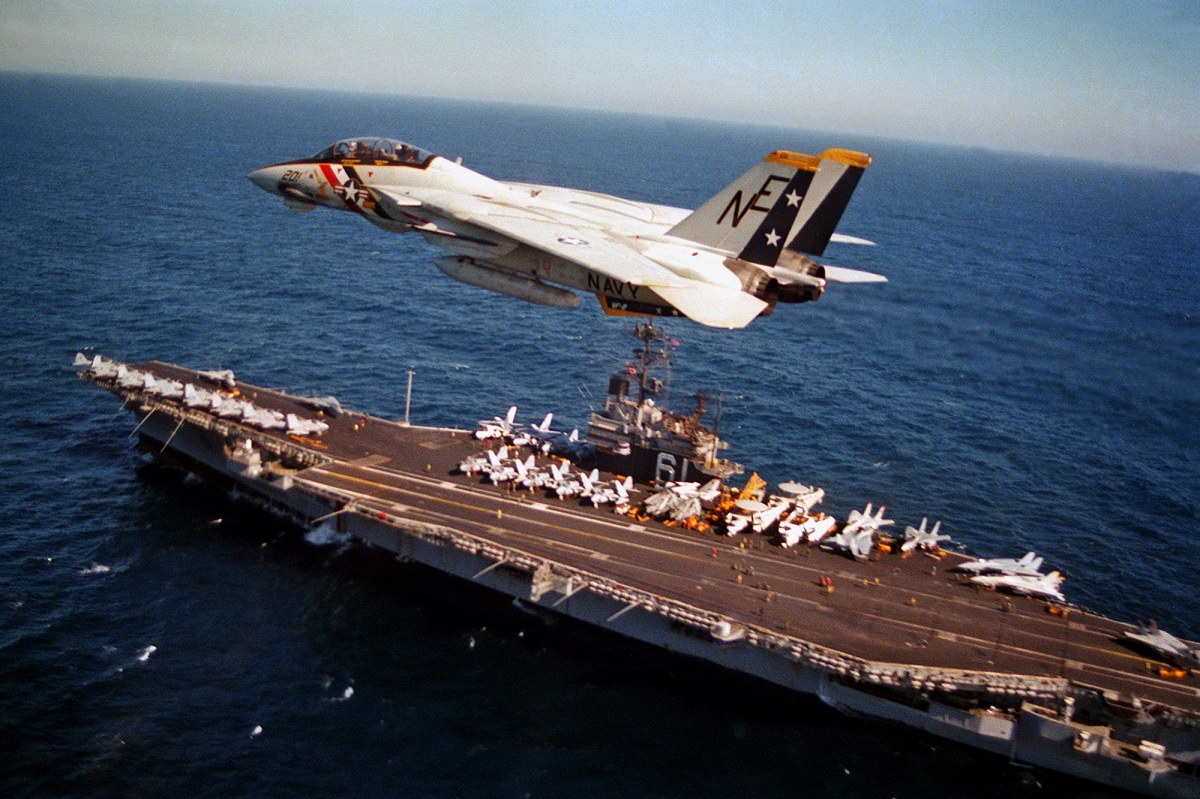‘I have actually done a fly by of the tower at over 400 knots…and I have photos to prove it,’ Dave “Bio” Baranek, former F-14 Tomcat RIO
Dave “Bio” Baranek was born and raised in Jacksonville, Florida, where he grew up drawing airplane pictures and putting together scale model airplane kits. In his early teens he set his sights on becoming a jet fighter pilot or radar intercept officer. He attended Georgia Tech and participated in the ROTC to qualify for officer training, then entered the Navy in 1979. Shortly after he joined his first squadron he received the callsign “Bio,” which many of his former squadronmates still call him.
He enjoyed a successful and satisfying 20-year career in the Navy, starting with assignments to F-14 Tomcat squadrons and the elite Topgun training program, and later assignment to the Joint Chiefs of Staff and the US 7th Fleet. At one point, he commanded an F-14 Tomcat fighter squadron, responsible for nearly 300 people and 14 aircraft worth about $700 million. He completed his career with 2,499.7 F-14 Tomcat flight hours and 688 carrier landings. His logbook also records 461.8 flight hours in the F-5F Tiger II. While serving as a Topgun air-to-air combat instructor in 1985, he had the unusual experience of flying aerial sequences used in the film “Top Gun,” starring Tom Cruise and produced by Jerry Bruckheimer and Don Simpson. He also served as a dialogue advisor on the project, and took some of the few available photographs of the movie’s black F-5 fighters in flight.
He retired from the Navy in 1999.
His three books, Topgun Days, Before Topgun Days and Tomcat RIO, tell many flying stories from his career, as well as presenting dozens of his photos.
#AW# asked its readers to submit questions about the F-14, the AIM-54 Phoenix and about how a Tomcat RIO could help his pilot during a dogfight. We chose the most interesting questions and we submitted them to Bio.
Here you find the first part of the Q&A with Bio.
This post instead features the final 14 answers.
1. Were there pilots you did not like to fly with? If so why and how do you handle them having your life in their hands?
Answering this could make me look picky, but since you asked…over my 2,500 F-14 hours there were a few pilots that I didn’t like flying with so much. Before I go any further, I’m sure there were a few pilots who didn’t like flying with me as much as other RIOs. I really enjoyed flying with the vast majority of pilots I flew with over the years, so this wasn’t a big problem anyway. And remember, we were flying to perform a mission, and that’s what we did, even if it wasn’t one of my “best buddies” that I was flying with.
As for putting my life in their hands, I didn’t fly with any pilot I considered incapable or dangerous, so that wasn’t an issue. Pilots and RIOs were continuously evaluated on their abilities, both informally and through formal tests and qualifications. The people who operated Tomcats ranged from very capable to truly amazing, so I really didn’t worry about putting my life in my pilot’s hands.

2. What is it like being a pilot/RIO in real life compared to simulators (especially the DCS Tomcat)?
Oh man, this is a good question. I’ll start with the little things, such as sitting on a hard ejection seat. The F-14 seat had a cushion and cooling air, but was still pretty uncomfortable after more than an hour (or less!). But that is the price you pay for sitting on an ejection seat in a fantastic jet fighter, so we didn’t complain. What kind of seat do you sit on for DCS? Probably pretty comfortable. Do you wear a torso harness and strap yourself in? Working while wearing the gear and strapped in would be cumbersome until you get used to it.
Then let’s talk about g forces. You feel g’s any time you turn; some people think it is when you go fast, but you don’t feel significant g’s if you fly in a straight line. If you’re not used to them, they can be very uncomfortable, and of course can make you black out. But once you’re used to them, as with the harness and strapped in, they are a part of the job and you deal with them basically subconsciously.
I agree that the visuals in DCS are phenomenal! Props to the developers who put in so much work to make it look realistic. But watching on a screen or even VR goggles just doesn’t compare to looking out of that huge canopy and seeing the world below you, or the clouds around you.
Now imagine that view after an oh-dark-thirty launch, when the world outside that huge canopy is pitch black, until the brilliant orange sunrise lights up the world and it means you’re going to get a day trap! Actually flying real aircraft is an immersive experience and you live it, day in and day out. The consequences of a mistake can be extreme. DCS is a task of choice and you can turn it on or off.
The squadron environment is also part of the experience that DCS just can’t provide. It was a varsity course in group dynamics. On the other hand, I don’t think DCS gives you paperwork!
3. When do you know you’ve reached the peak of the plane’s ability while flying?
There were several ways to know this in the F-14, at least when I flew it. Here’s a cool “seat of the pants” example: a dynamic cue called the edge of buffet, the aircraft shook as if it were going over a rough road. In very simple terms, this was when airflow was doing all it could do to make the aircraft maneuver, so if the pilot felt the edge of buffet he was getting the maximum turn. If he did not feel it, he wasn’t getting the maximum turn – but there could be a reason for that such as trying to increase speed. And if he pulled harder on the stick he could stall or depart the jet. (During straight and level flight or mild maneuvers, the F-14 was a smooth ride.)
Another way to know you’ve reached peak performance was to match the numbers developed by engineering calculations and test flying. This would be something like setting a particular climb angle at a certain airspeed, to know you were getting the best climb performance.
Yet another way to know would be to set control stick positions, such as pushing forward on the stick to achieve 0.5 to 0 g if you were trying to accelerate. This was called unloading and it reduced the induced drag normally generated by a wing, so you could accelerate faster.
4. Did RIOs have to wear glasses and/or contacts if they didn’t have 20/20 uncorrected vision?
Yes. Every RIO I knew wanted to have good vision, 20/20 or better, to perform at their best. They would wear glasses or contacts so they had this when flying. RIOs would compete with pilots for first tally-ho, so we wanted the best possible vision.
Some people don’t realize this, but Navy rules allowed a pilot to continue as a pilot if his vision deteriorated slightly after his initial training. As a result, some pilots wore glasses whenever they flew or when they were making a carrier approach, to see the ball better. Pilots usually called their glasses “cheaters.”
5. Did they ever launch a Phoenix in combat? If so, what happened?
I believe the US Navy has launched three Phoenix in combat situations, all during Operation Southern Watch.
- January 1999: Two F-14Ds from VF-213 each launched an AIM-54C at Iraqi MiG-25s; the rocket motors failed and the missiles fell to earth.
- September 1999: An F-14D from VF-2 launched one AIM-54C at an Iraqi MiG-23; the MiG turned away and the missile did not reach the target, which could be considered a mission kill.
Some sources have different details on these engagements.
I’ve said before that it is one of the disappointments of my life that American Tomcats have no combat Phoenix kills (even though I was not involved in any near-launch situations in operational flying). I’ve read with interest the stories of Iranian F-14 combat engagements and Phoenix kills.
The Phoenix was an impressive missile, and launching one was complex and exciting, even in a training environment. The first chapter in my book Tomcat RIO describes my missile exercise, shooting an AIM-54 at a jamming target.
6. Did you ever eject or fly with somebody that did?
Several people in training squadrons and in my first fleet squadron (VF-24) had ejected during their flying careers, and I found their stories fascinating: the idea of leaving a familiar and safe environment. (Yes, I considered the cockpit of a fighter a safe environment.)
Then on 19 December 1981 I myself had to eject during a carrier landing mishap. It was a split-second decision with absolutely no indication of approaching trouble. The reason was that one arresting cable was not set to the correct weight to stop an F-14, and that’s the one we caught. It slowed us down and then broke. When it broke we were going around 50 knots, which was too fast to stop on the flight deck and too slow to fly. My pilot evaluated the situation a bit faster than me and said, “Eject! Eject!” over the ICS, and I pulled the lower handle.
Our seats fired in the brief period when the jet was falling from the flight deck to the ocean surface, 60 feet below. My rocket ride was quite an experience, and then I had to deal with getting entangled in my parachute! But at least it was daytime and the water was warm, as we were near the middle of the Indian Ocean. I have to give credit to the maintenance technicians who maintained my ejection seat and survival equipment as well as the skilled helo crew from HS-8.
Here’s the video of our ejection.
7. As a RIO, how much of a role did you have from start up to shut down? Did the pilot and RIO perform preflight duties together or was everything done based on individual responsibilities? Was the workload more or less than the pilot? Did you have a chance to “enjoy” the flights?
I’m glad this question was submitted because it allows me to make a point about crew responsibilities. The Navy held F-14 pilots and RIOs to very similar levels of responsibility for the complete evolution: planning, preflight and start, flight, debrief. They took the exact same tests for safety and operational qualifications.
To cover some essentials: In the F-14 the pilot had the flight controls and was the aircraft commander. The RIO was the lead for navigation and communication. The mission commander could be a pilot or RIO, and this could apply to a single aircraft or multiple.
Within one aircraft, pilot and RIO responsibilities were integrated. The pilot literally signed for the aircraft (in the logbook), but pilot and RIO preflighted the entire aircraft, working separately and in opposite directions. In the F-14, the RIO had to participate in the start-up sequence to get the computers to do certain things for the plane to be fully operational, and the RIO had the IFF transponder controls.
While strapped in and flying, the RIO was expected to initiate checklists and ensure appropriate answers by the pilot. The RIO was to do everything possible to ensure effective and safe aircraft operation: visual lookout, switch positions, talking and listening to the radios, and so much more. They also had to coordinate closely for most of the flight.
I would say that during certain phases of flight the pilot’s workload was higher, and other phases the RIO’s would be higher. As for enjoying flights, on many flights there were definitely times when your brain could relax and you could enjoy the view, while on busier flights you had to enjoy it after landing!
8. What would you think it was like dogfighting with an Su-35 or Su-37 when you know it could do the Cobra and you will overshoot him reversing your role from hunter to hunted?
This is a classic situation for being aware of your opponent’s capabilities so you can avoid them. I would say if you’re in an F-14 fighting against an aircraft that can perform a cobra maneuver, you should avoid a high-overtake situation where he can do it. Also, maintain your energy, so if he does cobra, you can climb away. An aircraft that performs a cobra has his nose up briefly, but then has to lower it to regain some energy. This also makes him fairly predictable for a period of time.
The F-14 also had good ability to pitch up and generate high overtake, although I don’t think it was quite as dramatic as a cobra. After the pitch up maneuver, however, the F-14 would be slow and relatively vulnerable until it regained airspeed.

9. Is it difficult to learn the sign language used between pilot and deck crew ?
Not really, as most signs have a basis in familiar things. Electrical power, for example, was two fingers of one hand stuck into the palm of the other, like an electrical plug into an outlet. They are also the same signals used for land-based ops, so we practiced them all the time.
10. Did you have the chance to fly the Tomcat in the air-to-ground role?
Yes, I flew air-to-ground during my final squadron tour, 1996-98 with VF-211. All of my training and experience for the first ten years of my flying career was air-to-air, so it was new to me. I received training in the RAG when I went through for a refresher, but fortunately I found that VF-211 had an excellent training program and was full of conscientious aviators. That meant we had good flight briefs, disciplined execution, and thorough debriefs. We also used LANTIRN when we deployed, and I would say it was easy to become proficient with the controls and displays. LANTIRN made the F-14 a very effective precision bomber.
Mentioning the training program in VF-211, I have to acknowledge the Strike Fighter Weapons and Tactics (SFWT) program implemented throughout Navy F-14 and F/A-18 squadrons. It raised the level of training and flight execution throughout the fleet.
11. Were there ever mock engagements with F-15 Eagles? And if so, who won more?
There were mock engagements, which we called by the general term ACM (air combat maneuvering). I really don’t know who won more, I don’t think anyone kept those kinds of records, especially over the long run.
There is a lot of “trash talk” about this, but I’ll give you some straight answers. The F-15 is a very capable aircraft and the USAF pilots I faced were well-trained. In a 1v1 the F-14 pilot would have to fly his jet very well … or break some rules such as lower the flaps. (There are videos and comments online by pilots who broke those rules, I’m not going to discuss them further.) In a multi-aircraft engagement the Eagle’s relative strengths were reduced. When I fought F-15s, which was not often enough, we did our best in the multi-aircraft environment. Out of my entire career I have a video of ONE engagement: a 2v2 against F-15s. Here’s a screen shot from about one minute after the merge, when my pilot got into position to launch an AIM-9 at an F-15. You can tell we’re in good position with Sidewinder (SW) selected. The image flickered a lot so the trigger-down cue has already gone.

12. In your expert opinion, do you think that the Iranian claims of over 100 kills by the F-14 during the Iran-Iraq War are true?
This is a sensitive topic due to the deep political divide between the United States and Iran, so I will only give a short answer. I do think Iranian Tomcat pilots and RIOs had good success with the F-14 in combat. The Tomcat is a versatile and capable aircraft, and their crews were initially trained by US Navy instructors.
13. What does it feel like when you do a 4G inverted dive along a MiG-28 somewhere over the Indian Ocean?
That’s classified. I could tell you, but then I’d have to kill you.
14. What’s it like to do a fly by of the tower at over 400 knots?
I have actually done a fly by of the tower at over 400 knots…and I have photos to prove it.


Navy aircraft regularly performed fly bys of the carrier when we were operating at sea, as a way to let the hard-working squadron members see their work in action: flying. Different ships and squadrons had different rules, but when the rules were announced they were usually followed or the crew risked being grounded.
Flying at low altitude, over land or water, is exciting because the sense of speed is greater. But doing a fly by is a good chance to remember some basics, such as planning and control. Plenty of aviators have been killed doing unplanned fly bys or “pushing it” too much. It didn’t always take a great deal of planning, but thinking ahead and deciding what you were going to do would help you complete the fly by and look good doing it.
Note: Once again, Bio would like to thank Jon “Hooter” Schreiber and Dave “Hey Joe” Parsons for their assistance
Photo by Dave “Bio” Baranek and digital image by Dorian Dogaru


